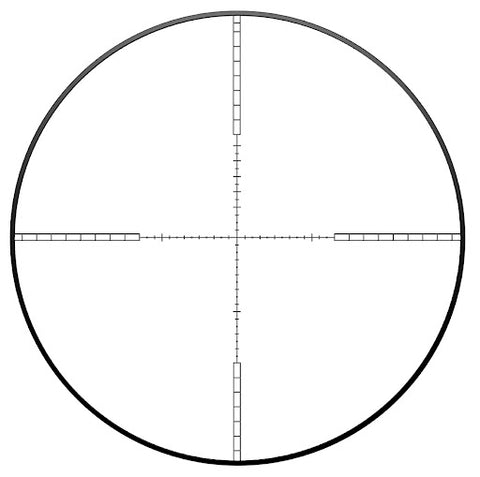When it comes to rifle scopes, there are two options: an MOA-based or MIL-based scope. Both options are based on their own set of mathematics, and if you have no prior knowledge, you may be wondering which choice is ideal for you. Because both systems have distinct advantages and limitations, this article will help you decide which one you need to choose.
Table of Contents
What Are MIL Reticles?

Credit: Riflesscopesuk
MIL is an abbreviation for “milliradians” or “mils”. These scopes communicate ranging in meters and centimeters. They are most commonly used among law enforcement and military personnel.
When looking through a MIL scope you’ll see crosshairs as well as dots. The gap between these dots reflects a height of 10 centimeters or 3.6 inches on your target at 100 yards, which is a normal distance for sighting in a hunting rifle. The representative distance between your MIL-dots changes as the distance to your target grows or reduces
What Are MOA Reticles?

Credit: MidwayUSA
MOA or “minute of angle” is an angular measurement within a circle. It is similar to a MIL scope in appearance but differs in size, with MIL being the bigger of the two. Additionally, MOA is a little easier to grasp than MIL.
Like a MIL scope, you will be able to see crosshairs as well as lines or dots through an MOA scope. Using the earlier 100-yard scenario, the space between these dots corresponds to a height of 1.047 inches. Because 1.047 inches is so close to one inch, it is typically rounded down. Therefore, one MOA is equivalent to one inch at 100 yards.
MIL vs MOA Scopes: What’s the Difference?

Credit: Envato Elements/ FabrikaPhoto
Although MOA and MIL dot scopes look similar, there are a few differences that distinguish them:
- An MOA reticle scope is more accurate than a MIL dot scope.
- A MIL reticle is larger than an MOA scope.
- MOA adjustments are easier to adjust since they use yards and inches rather than centimeters and meters.
Which One Should You Choose?

Credit: Envato Elements/ byrdyak
When comparing MIL against MOA, neither MIL nor MOA has an edge. Both are angular measurements. The best one for you is determined by your knowledge and comfort level with the system.
However, if you are unfamiliar with scopes, here are two variables that will help you make a decision:
- If you’re used to thinking in inches and yards and have expertise in MOA, you might want to stick with it. However, if you are familiar with the metric system or are starting from scratch and do not have MOA expertise, you may want to use MIL scopes.
One option to explore for MIL scopes is the Hawke Vantage Riflescope, while for MOA scopes, the Vortex Optics Red Dot Sight is a noteworthy consideration.
- Another thing to think about is what unit your competitors or friends will be using. When a competitor gets off the line, you should be able to communicate and understand what he is saying.
How to Zero Your Scope Using an MOA Reticle or MIL Dot
If you’re new to zeroing a scope reticle, here are a few steps to get you started:
1) Set Your Target

Credit: Envato Elements/ MargJohnsonVA
Begin by selecting an appropriate target like those from EasyShot. These targets are ideal for range practice or dry firing.
Once you have your target, set it on a solid stand 100 yards away from the shooting station. When it comes to your shooting station, ensure that your rifle is properly supported so that you can fire repeatedly.
2) Begin With the First Shot Group

Credit: Envato Elements/ StudioPeace
To zero your scope, start by firing three-shot groups. Set your scope’s crosshairs to the center of the aiming spot and take three shots.
3) Calculate the Corrections

Credit: Envato Elements/ Vailery
Examine the point of impact of your shot. This will determine how much you need to adjust your scope. Estimate the middle of the shots on the target and utilize that position for corrections. The relative center of the shot group shows the average impact point of the shots.
4) Shoot Three More Times at the Same Target

Credit: Envato Elements/ StudioPeace
Hold the sight reticle at the same shooting position as the first round and release three more shots. This shot should hit the target. You may need to make some little tweaks to get your fire cluster precisely where you’d like them. Carefully calculate the necessary modifications.
5) Check Your Settings and Adjust the Aiming Point

Credit: Envato Elements/ orcearo
Move your target and discharge three more shots once you’re pleased with your sight settings. Because you’ll need to reposition your rifle and scope, this will immediately inform you if your sight settings are precise and reliable.
Summary
An MOA and MIL dot reticle is best used for long-range shooting. When choosing between the two, keep your goals in mind. A skilled marksman can make the most of any rifle scope. After all, the greatest precision comes from time behind the trigger, not from reading reviews.








































